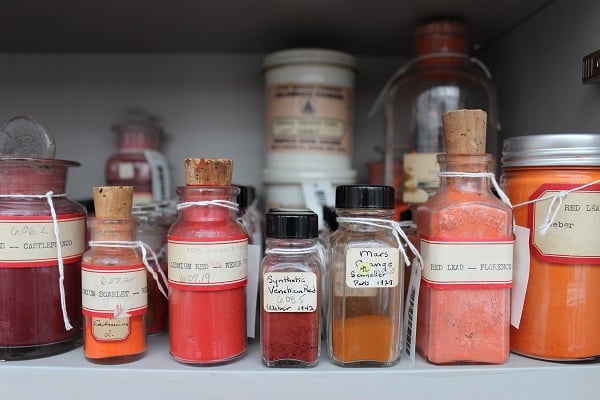
Photo: Jenny Stenger.
Art conservation departments are more or less ubiquitous in museums today, but it wasn’t always this way.
The first dedicated conservation facility in the United States wasn’t founded until 1927, when Edward Forbes, then-director of Harvard University’s Fogg Museum, initiated the museum’s department of research and restoration.
Forbes had a personal stake in art preservation. Attending to his own collection of Renaissance paintings (like this Madonna he bought in Italy), he traveled the world collecting rare pigments to improve identification and conservation efforts—and he created a chromatic archive in the process.
The organization of the Forbes pigment collection was inspired by an artist’s color wheel.
Photo: Zak Jensen, © President and Fellows of Harvard College
The Fogg’s department of research and restoration is now the Straus Center for Conservation and Technical Studies, one of four research centers at the Harvard Art Museums. Helmed by director and senior conservation scientist Narayan Khandekar, the collection comprises over 3,600 items which are on display in the Straus Center’s analytical labs.
Besides the meticulously-organized pigments, the center also houses binding media, historical scientific equipment, and raw material samples.
The pigments aid research and conservation work.
Photo: Jenny Stenger, © President and Fellows of Harvard College.
While the Forbes Collection and the Straus Center improved conservation efforts, they’ve also been instrumental in research and, notably, authentication. In 2007, Harvard Art Museums undertook an investigation into 3 of 32 paintings thought to be by Jackson Pollock.
The paintings were found in a storage facility in Long Island in 2002 by Alex Matter, who claimed they were finished by Pollock in the studio of Matter’s father, photographer Herbert Matter. The authenticity of these paintings were questioned soon after the study.
Black pigments in the Forbes collection.
Photo: Jenny Stenger.
Using a technique called laser desorption ionization mass spectrometry (LDI MS), the researchers identified some common nineteenth- and twentieth-century pigments, like synthetic yellow ochre, synthetic ultramarine blue, and titanium white. But they also found materials like PO 43, an orange pigment that wasn’t commercially available as paint until 1950, as well as PY 151, another hue of orange that wasn’t patented until 1969, and PR 254, a red pigment discovered in 1974.
The paintings in question were thought to have been created between 1946 and 1949, and Pollock died in 1956. He was also known to use commercial house paints, rather than mixing his own pigments, so the study cast serious doubt on a number of paintings that already lacked the aesthetic sophistication of authenticated Pollocks.
Many of the pigments are stored in their original containers.
Photo: Peter Vanderwarker
The pigment collection holds other scandalous stories. One researcher found Indian Yellow in Seurat’s 1879 Vase of Flowers, a pigment outlawed in 1908 on grounds of animal cruelty—the color was made from the urine of cows that had been fed nothing but mango leaves.
And if that seems awful, just wait until you hear about Mummy Brown, a pigment made from the ground-up remains of Egyptian mummies.
Some yellow pigments from the Forbes collection. Courtesy Peter Vanderwarker.
In a quest to conserve a beloved personal collection, Forbes began a decades-long exploration into color. In contrast, the Metropolitan Museum of Art didn’t create a conservation department of their own until 1942—and it was a Fogg alum who established it.